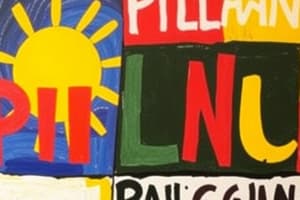Podcast
Questions and Answers
What is the national language of the Philippines?
What is the national language of the Philippines?
- Cebuano
- Filipino (correct)
- Tagalog
- Ilocano
English is not an official language of the Philippines.
English is not an official language of the Philippines.
False (B)
Filipino is primarily based on the ______ language.
Filipino is primarily based on the ______ language.
Tagalog
In what year was Tagalog selected as the basis for the national language?
In what year was Tagalog selected as the basis for the national language?
There are fewer than 100 languages spoken in the Philippines.
There are fewer than 100 languages spoken in the Philippines.
The official regulatory body for the Filipino language is the Komisyon sa Wikang ______.
The official regulatory body for the Filipino language is the Komisyon sa Wikang ______.
How many letters are there in the Filipino alphabet?
How many letters are there in the Filipino alphabet?
Filipino uses the Cyrillic alphabet.
Filipino uses the Cyrillic alphabet.
In Filipino grammar, the word order is typically subject-verb-______.
In Filipino grammar, the word order is typically subject-verb-______.
Which of the following contributed many words to Filipino vocabulary, especially in religion and government?
Which of the following contributed many words to Filipino vocabulary, especially in religion and government?
Filipino pronunciation is considered complex and difficult to learn.
Filipino pronunciation is considered complex and difficult to learn.
Stress in Filipino words often falls on the ______ syllable.
Stress in Filipino words often falls on the ______ syllable.
Which of the following is a common verb affix in Filipino?
Which of the following is a common verb affix in Filipino?
Nouns in Filipino are inflected for gender.
Nouns in Filipino are inflected for gender.
The plural marker for nouns in Filipino is ______.
The plural marker for nouns in Filipino is ______.
In what areas is Filipino used?
In what areas is Filipino used?
Proficiency in Filipino is not important for employment in the Philippines.
Proficiency in Filipino is not important for employment in the Philippines.
The Filipino phrase for 'Thank you' is ______.
The Filipino phrase for 'Thank you' is ______.
Which of the following phrases means 'Good morning' in Filipino?
Which of the following phrases means 'Good morning' in Filipino?
Match the Filipino phrase to its English translation:
Match the Filipino phrase to its English translation:
Flashcards
What is Filipino?
What is Filipino?
The national language of the Philippines, based on Tagalog and influenced by other languages.
Komisyon sa Wikang Filipino (KWF)
Komisyon sa Wikang Filipino (KWF)
The commission that regulates and develops Filipino, promoting it through research and education.
Agglutinative Morphology
Agglutinative Morphology
A language where words are formed by adding prefixes, suffixes, infixes, and circumfixes to root words.
Subject-Verb-Object (SVO)
Subject-Verb-Object (SVO)
Signup and view all the flashcards
Loanwords
Loanwords
Signup and view all the flashcards
The 'ng' sound
The 'ng' sound
Signup and view all the flashcards
What does 'mga' indicate?
What does 'mga' indicate?
Signup and view all the flashcards
Linker words 'na' or '-ng'
Linker words 'na' or '-ng'
Signup and view all the flashcards
Language usage in Schools
Language usage in Schools
Signup and view all the flashcards
"Kumusta ka?"
"Kumusta ka?"
Signup and view all the flashcards
"Salamat"
"Salamat"
Signup and view all the flashcards
"Walang anuman"
"Walang anuman"
Signup and view all the flashcards
"Paalam"
"Paalam"
Signup and view all the flashcards
Magandang umaga
Magandang umaga
Signup and view all the flashcards
Magandang hapon
Magandang hapon
Signup and view all the flashcards
Magandang gabi
Magandang gabi
Signup and view all the flashcards
Oo
Oo
Signup and view all the flashcards
Hindi
Hindi
Signup and view all the flashcards
Magandang araw
Magandang araw
Signup and view all the flashcards
Study Notes
- Filipino serves as the national language of the Philippines.
- It shares official language status with English in the country.
- Tagalog forms the foundation of Filipino.
- Influences from other Philippine languages, Spanish, and English are incorporated into Filipino.
History and Development
- The Philippines boasts a rich linguistic diversity, with over 170 languages spoken.
- Tagalog was chosen as the basis for the national language in 1937.
- In 1959, Tagalog's name was officially changed to Pilipino.
- The 1987 Constitution mandated renaming it to Filipino, broadening its base to include more languages.
- The Komisyon sa Wikang Filipino (Commission on the Filipino Language), or KWF, is the official regulatory body
- The KWF furthers the development of Filipino by research, educational initiatives, and publications.
Linguistic Features
- The Latin alphabet is used in Filipino.
- It comprises 28 letters.
- The vowels are a, e, i, o, u.
- The consonants are b, c, d, f, g, h, j, k, l, m, n, ñ, ng, p, q, r, s, t, v, w, x, y, z.
- Filipino employs agglutinative morphology.
- Words are built through the addition of affixes to root words.
- Reduplication is a common feature.
- Filipino grammar typically follows a subject-verb-object (SVO) word order.
- Case markers indicate grammatical function.
- Common case markers include "ang" (nominative), "ng" (genitive), and "sa" (oblique).
Vocabulary
- Filipino's vocabulary sources are varied.
- Tagalog provides the core vocabulary.
- Spanish provides contributions in religion, government, and common items.
- English supplies modern and technical terms.
- Other Philippine languages, including Cebuano, Ilocano, and Hiligaynon, add to the vocabulary.
- Loanwords often undergo nativization.
Pronunciation
- Filipino pronunciation is generally straightforward.
- Typically, each letter corresponds to a single sound.
- Vowel sounds are similar to those in Spanish or Italian.
- Consonant pronunciations are generally like English, with some differences.
- The "ng" sound is similar to the "ng" in "sing".
- Stress can change word meaning.
- Stress usually falls on the penultimate syllable.
Grammar
- Verb conjugations are complex.
- Affixes denote tense, aspect, and mood.
- Common verb affixes include "-um-," "mag-," "i-," and "-an."
- Nouns do not inflect for gender or number.
- Plurality is indicated by the marker "mga."
- Adjectives typically precede the nouns they modify.
- The linkers "na" or "-ng" connect adjectives to nouns.
- Possessive pronouns: "ko," "mo," "niya," "natin," "namin," "ninyo," and "nila."
- Demonstrative pronouns: "ito," "iyan," and "iyon."
- Interrogative pronouns: "sino," "ano," "saan," "kailan," and "bakit."
- Adverbs modify verbs, adjectives or other adverbs..
- Common adverbs: "dito," "doon," "ngayon," "kahapon," and "bukas."
- Prepositions show relationships between nouns or pronouns and other words.
- Common prepositions: "sa," "ng," "para sa," and "ayon sa."
Usage and Importance
- Filipino is used in government, education, media, and business.
- It is a language of instruction in schools, alongside English.
- Many television shows, movies, and music are produced in Filipino.
- Filipino is a symbol of national identity.
- It promotes unity and understanding among Filipinos from different regions.
- Proficiency in Filipino is important for employment and social interaction in the Philippines.
Common Phrases
- "Kumusta ka?" - How are you?
- "Magandang araw" - Good day
- "Salamat" - Thank you
- "Walang anuman" - You're welcome
- "Oo" - Yes
- "Hindi" - No
- "Paalam" - Goodbye
- "Magandang umaga" - Good morning
- "Magandang hapon" - Good afternoon
- "Magandang gabi" - Good evening
Studying That Suits You
Use AI to generate personalized quizzes and flashcards to suit your learning preferences.




